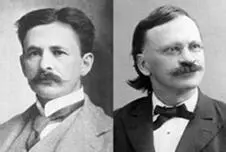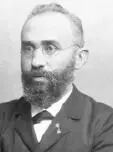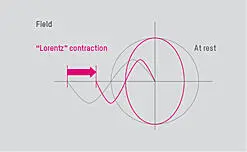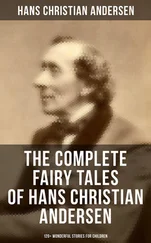
Albert Michelson, 1852–1932 ; Edward Morley,
1838–1923
Knowledge grows from the resolution of contradictions, and the contradiction first resolved by Einstein was this: if a source of light moves towards an observer at speed v , and the light is moving away from the source at the speed of light c , the observer intuitively expects an arrival speed of c + v . But in the 1880s, it was determined by measurement that the velocity was c in all circumstances (Michelson and Morley). How did Einstein resolve this contradiction? His very first step contains all the irritation of the later results: he said to himself that if the speed of light is to remain constant at c regardless of the position of the observer, then distance and time simply have to be “relativised”. Instead of Newton’s space and time, he therefore proposed c as the absolute. He then tested out how a system of coordinates K’ with its origin in the light source would have to relate to the observer’s system of coordinates K , to enable light both to be emitted from there at c .
His conclusion was that space and time are contracted around the light source, but the consequences go much further: mass increases as v increases and thus also the momentum (momentum = mass multiplied by velocity). A momentum3 has an energy and a cross-multiplication supplies directly the result of the century—that this energy is not zero, even at rest, but the famous E rest= mc2 .4
Einstein would have been severely taken aback had he realised that his result originated in Newton’s formulation of the momentum conservation law: if Newton had simply written “force equals mass multiplied by acceleration”, Einstein would not have made such a leap forward. He was merely lucky, since in 1905 there was as yet no experimental proof that Newton’s intuitive formulation applies.5 But even leaving this aside there was great cause for amazement as kinetic energy was now to be understood as a pure increase of something that no-one had bargained with: rest energy mc 2. It is an indication that that mass is a dynamic, not a corpuscle.
The simple reason for this, that light from any source is radiated at c and received by any mass at c , regardless of whether they are moving relative to one another, depends from the point of view of deductive physics on the fact that
–the continuum directly on the surface of a mass is at rest (in the same way that air is at rest on the outer ear despite the strongest wind—it does not blow into or through the ear),
–the speed of propagation of all disturbances (such as waves) in a continuum at rest is c .

Hendrik Antoon Lorentz,
1853–1928
However the frequency of lightwaves hitting the observer should not merely be expected in terms of linear addition (the original quantity of signals per second plus the gain from the approach6), as the field of a mass, spherical when at rest, is contracted if it moves at v relative to the continuum—like a source in the countercurrent. This shortens the wavelength of the radiation by the factor known as the Lorentz contraction, and the frequency is increased in inverse proportion, which leads to the Doppler effect7, in which the frequency increases at more than a linear rate, and for v → c becomes infinite (approximately corresponding to a sonic boom). This enables all the results of the special theory of relativity to be understood and also some of those of the general theory of relativity, if kinetic potential is replaced by gravitational potential in the formulae. The assumption of a continuum and the representation of a mass dynamic within is therefore sufficient to avoid the concept, incompatible with thinking, that space and time can expand and bend.
The predictions of the theory of relativity are true, but Einstein’s interpretations of the correct mathematical results as the expansion of space and time should be replaced:
–It is not that the time of the mass in motion moves more slowly, but that its signals take longer to reach the observer,
–Space does not expand or contract, but the continuum in space, similar to the air that flows around a body,
–It is not the mass that increases with velocity, but its effect—similar to the pattering of rain at high speed against a windscreen,
–Mass should be thought of as a dynamic, as compelled by E= mc2 , and the idea of literally inconceivable corpuscles should be abandoned.

Lorentz contraction
Ultimately, the theory of relativity only formalises the relativity of interactions: as a motorbike approaches a listener, the listener registers higher-frequency sounds, and as it goes away, lower. The theory of relativity does not offer anything else to philosophy, although it introduced a new era in physics.
Irritation from quantum mechanics
As an infant’s consciousness first begins to develop, there is an undirected movement of the limbs until an effect is achieved; after several repetitions this is then stored as an action-effect pattern. The action does not result from a physiological need, but a reflex that trains the brain. The pattern contains the idea prior to the triggering of the action, in the same way as a bird “imagines” the landing before settling onto a branch.
In this way, infants register their own intentions, and at nine months children recognise their intentions to such an extent that they can also recognise those of other people. Others are understood per se as intentional beings with intentions analogous to those of the child. This is manifested in the form of pointing to things and persons, in other words in attracting people’s attention, something that is not observed even among the most attentive of the other primates.Tomasello By analogy, children later attribute intention to all processes, saying things like, “The ball wants to come to me” and seeking intention everywhere: “Why does a cherry tree want to blossom?” Theories of cause are also stated: “The moon shines so we can find our way home.” The history of ideas began in similar fashion: mythologies invented beings with intentions in response to questions of cause and purpose; religions responded with creation stories.
A child of western civilisation gradually learns to transpose intentionality into causality and explain reality from reality. This was the giant step forward made by the pre-Socratic philosophers with the causality principle: “Everything has a cause” and the law of cause and effect: “Equal causes have equal effects”.
One of the first experiences of causality a child encounters is that a body which was there first must be removed if another is to take its place. Kant considered causality to be a priori; however, it is not to the extent that, in the final regression, it is attributable to the fact that space can only be occupied by one single body, and so is already contained in the three a priori intuitions of space, time and body. Causality describes sequences of conditions, of stationary images, the earlier of which are termed causes and the later, effects. The stationary images are subjective constructs—considered objectively, “everything is in a state of flux”, one thing flows from another, and in this sense everything that happens is from the outset “causal”.
Читать дальше















